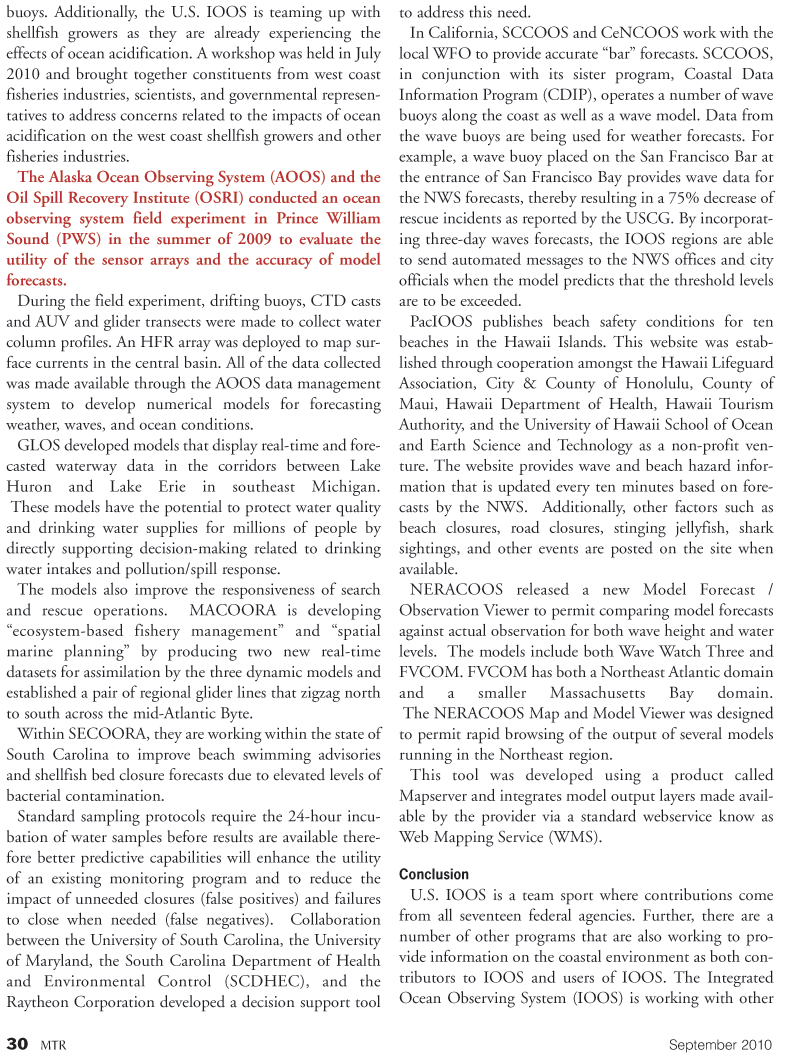
Page 30: of Marine Technology Magazine (September 2010)
Ocean Observation
Read this page in Pdf, Flash or Html5 edition of September 2010 Marine Technology Magazine
buoys. Additionally, the U.S. IOOS is teaming up with shellfish growers as they are already experiencing the effects of ocean acidification. A workshop was held in July 2010 and brought together constituents from west coast fisheries industries, scientists, and governmental represen- tatives to address concerns related to the impacts of ocean acidification on the west coast shellfish growers and other fisheries industries.
The Alaska Ocean Observing System (AOOS) and the
Oil Spill Recovery Institute (OSRI) conducted an ocean observing system field experiment in Prince William
Sound (PWS) in the summer of 2009 to evaluate the utility of the sensor arrays and the accuracy of model forecasts.
During the field experiment, drifting buoys, CTD casts and AUV and glider transects were made to collect water column profiles. An HFR array was deployed to map sur- face currents in the central basin. All of the data collected was made available through the AOOS data management system to develop numerical models for forecasting weather, waves, and ocean conditions.
GLOS developed models that display real-time and fore- casted waterway data in the corridors between Lake
Huron and Lake Erie in southeast Michigan.
These models have the potential to protect water quality and drinking water supplies for millions of people by directly supporting decision-making related to drinking water intakes and pollution/spill response.
The models also improve the responsiveness of search and rescue operations. MACOORA is developing “ecosystem-based fishery management” and “spatial marine planning” by producing two new real-time datasets for assimilation by the three dynamic models and established a pair of regional glider lines that zigzag north to south across the mid-Atlantic Byte.
Within SECOORA, they are working within the state of
South Carolina to improve beach swimming advisories and shellfish bed closure forecasts due to elevated levels of bacterial contamination.
Standard sampling protocols require the 24-hour incu- bation of water samples before results are available there- fore better predictive capabilities will enhance the utility of an existing monitoring program and to reduce the impact of unneeded closures (false positives) and failures to close when needed (false negatives). Collaboration between the University of South Carolina, the University of Maryland, the South Carolina Department of Health and Environmental Control (SCDHEC), and the
Raytheon Corporation developed a decision support tool to address this need.
In California, SCCOOS and CeNCOOS work with the local WFO to provide accurate “bar” forecasts. SCCOOS, in conjunction with its sister program, Coastal Data
Information Program (CDIP), operates a number of wave buoys along the coast as well as a wave model. Data from the wave buoys are being used for weather forecasts. For example, a wave buoy placed on the San Francisco Bar at the entrance of San Francisco Bay provides wave data for the NWS forecasts, thereby resulting in a 75% decrease of rescue incidents as reported by the USCG. By incorporat- ing three-day waves forecasts, the IOOS regions are able to send automated messages to the NWS offices and city officials when the model predicts that the threshold levels are to be exceeded.
PacIOOS publishes beach safety conditions for ten beaches in the Hawaii Islands. This website was estab- lished through cooperation amongst the Hawaii Lifeguard
Association, City & County of Honolulu, County of
Maui, Hawaii Department of Health, Hawaii Tourism
Authority, and the University of Hawaii School of Ocean and Earth Science and Technology as a non-profit ven- ture. The website provides wave and beach hazard infor- mation that is updated every ten minutes based on fore- casts by the NWS. Additionally, other factors such as beach closures, road closures, stinging jellyfish, shark sightings, and other events are posted on the site when available.
NERACOOS released a new Model Forecast /
Observation Viewer to permit comparing model forecasts against actual observation for both wave height and water levels. The models include both Wave Watch Three and
FVCOM. FVCOM has both a Northeast Atlantic domain and a smaller Massachusetts Bay domain.
The NERACOOS Map and Model Viewer was designed to permit rapid browsing of the output of several models running in the Northeast region.
This tool was developed using a product called
Mapserver and integrates model output layers made avail- able by the provider via a standard webservice know as
Web Mapping Service (WMS).
Conclusion
U.S. IOOS is a team sport where contributions come from all seventeen federal agencies. Further, there are a number of other programs that are also working to pro- vide information on the coastal environment as both con- tributors to IOOS and users of IOOS. The Integrated
Ocean Observing System (IOOS) is working with other 30 MTR September 2010

 29
29

 31
31
